[文章]OpenHarmony轻量系统开发【4】编写第一个程序、启动流程分析
0
5
摘要:本文简单介绍如何编写第一个hello world程序,以及程序是被执行的
适合群体:适用于Hi3861开发板,启动流程分析
4.1编写第一个程序
编写一个hello world程序比较简单,可以参考官网:
https://gitee.com/openharmony/do ... cation-framework.md
本文在这里做下总结:
(1)确定目录结构。
开发者编写业务时,务必先在./applications/sample/wifi-iot/app路径下新建一个目录(或一套目录结构),用于存放业务源码文件。
例如:在app下新增业务my_first_app,其中hello_world.c为业务代码,BUILD.gn为编译脚本,具体规划目录结构如下:
- .
- └── applications
- └── sample
- └── wifi-iot
- └── app
- │── my_first_app
- │ │── hello_world.c
- │ └── BUILD.gn
- └── BUILD.gn
(2)编写业务代码。
在hello_world.c中新建业务入口函数HelloWorld,并实现业务逻辑。并在代码最下方,使用 HarmonyOS启动恢复模块接口SYS_RUN()启动业务。(SYS_RUN定义在ohos_init.h文件中)
- #include <stdio.h>
- #include "ohos_init.h"
- #include "ohos_types.h"
- void HelloWorld(void)
- {
- printf("___________>>>>>>>>>>>>>>>>>>>> [DEMO] Hello world.n");
- }
- SYS_RUN(HelloWorld);
(3)编写用于将业务构建成静态库的BUILD.gn文件。
如步骤1所述,BUILD.gn文件由三部分内容(目标、源文件、头文件路径)构成,需由开发者完成填写。以my_first_app为例,需要创建./applications/sample/wifi-iot/app/my_first_app/BUILD.gn,并完如下配置。
- static_library("myapp") {
- sources = [
- "hello_world.c"
- ]
- include_dirs = [
- "//utils/native/lite/include"
- ]
- }
static_library中指定业务模块的编译结果,为静态库文件libmyapp.a,开发者根据实际情况完成填写。
sources中指定静态库.a所依赖的.c文件及其路径,若路径中包含"//"则表示绝对路径(此处为代码根路径),若不包含"//"则表示相对路径。
include_dirs中指定source所需要依赖的.h文件路径。
(4)编写模块BUILD.gn文件,指定需参与构建的特性模块。
配置./applications/sample/wifi-iot/app/BUILD.gn文件,在features字段中增加索引,使目标模块参与编译。features字段指定业务模块的路径和目标,以my_first_app举例,features字段配置如下。
- import("//build/lite/config/component/lite_component.gni")
- lite_component("app") {
- features = [
- "my_first_app:myapp",
- ]
- }
my_first_app是相对路径,指向./applications/sample/wifi-iot/app/my_first_app/BUILD.gn。
myapp是目标,指向./applications/sample/wifi-iot/app/my_first_app/BUILD.gn中的static_library("myapp")。
4.2 Hi3861相关代码结构
目前hi3861用的是liteos-m内核,但是目前hi3681的liteos-m被芯片rom化了,固化在芯片内部了。所以在harmonyOS代码是找不到hi3861的内核部分。
但是这样不妨碍我们去理清hi3861的其他代码结构。
hi3861平台配置文件位于:
vendorhisiliconhispark_pegasusconfig.json

可以看到该配置文件有很多内容,
第一段这里指定了产品名称、版本、使用的内核类型
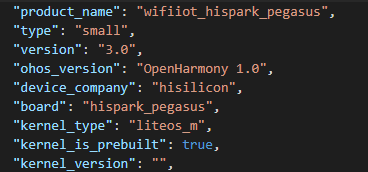
下面这里都是子系统:
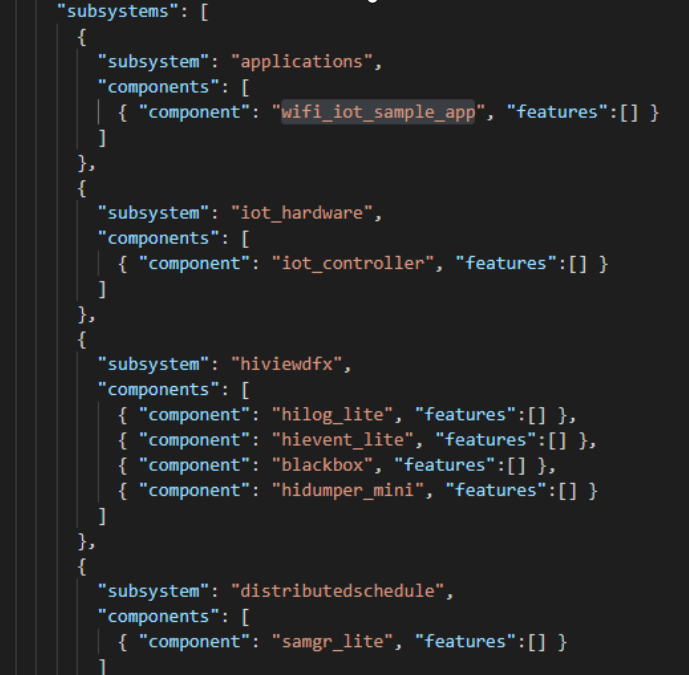
其中我们重点关注这几个模块:
(1)applications:应用子系统
路径:applications/sample/wifi-iot/app
作用:这个路径下存放了hi3681编写的应用程序代码,例如我们刚刚写得hello world 代码就放在这个路径下。
(2)iot_hardware:硬件驱动子系统
头文件路径: baseiot_hardwareperipheralinterfaceskits
具体代码路径,由deviceboardhisiliconhispark_pegasusliteos_mconfig.gni文件中指定:

config.gni文件内容较多,后续会一一解读
作用:存放了 hi3681 芯片相关的驱动、例如spi、gpio、uart等。
(3)xts:xts测试子系统。
这里我们先不要xts子系统,不然每次开机后,系统都要跑xts认证程序,影响我们后面测试,我们先注删除,如下:
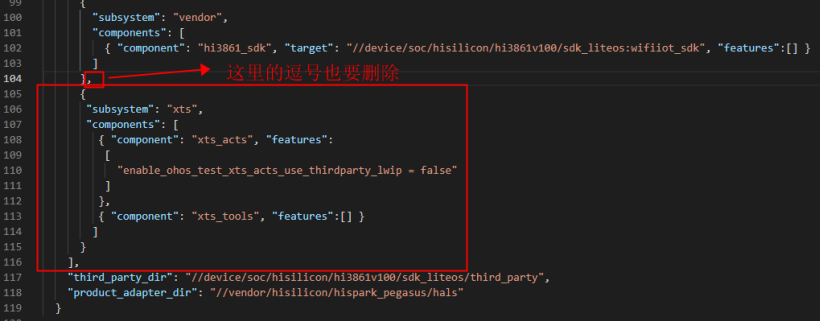
4.3 Hi3861启动流程
由于hi3681的liteos-m被芯片rom化了,固化在芯片内部了。所以我们主要看内核启动后的第一个入口函数。
代码路径:
devicesochisiliconhi3861v100sdk_liteosappwifiiot_appsrcapp_main.c
- hi_void app_main(hi_void)
- {
- #ifdef CONFIG_FACTORY_TEST_MODE
- printf("factory test mode!rn");
- #endif
- const hi_char* sdk_ver = hi_get_sdk_version();
- printf("sdk ver:%srn", sdk_ver);
- printf("_____>>>>>>> lza %s %drn", __FILE__, __LINE__);
- hi_flash_partition_table *ptable = HI_NULL;
- peripheral_init();
- peripheral_init_no_sleep();
- #ifndef CONFIG_FACTORY_TEST_MODE
- hi_lpc_register_wakeup_entry(peripheral_init);
- #endif
- hi_u32 ret = hi_factory_nv_init(HI_FNV_DEFAULT_ADDR, HI_NV_DEFAULT_TOTAL_SIZE, HI_NV_DEFAULT_BLOCK_SIZE);
- if (ret != HI_ERR_SUCCESS) {
- printf("factory nv init failrn");
- }
- /* partion table should init after factory nv init. */
- ret = hi_flash_partition_init();
- if (ret != HI_ERR_SUCCESS) {
- printf("flash partition table init fail:0x%x rn", ret);
- }
- ptable = hi_get_partition_table();
- ret = hi_nv_init(ptable->table[HI_FLASH_PARTITON_NORMAL_NV].addr, ptable->table[HI_FLASH_PARTITON_NORMAL_NV].size,
- HI_NV_DEFAULT_BLOCK_SIZE);
- if (ret != HI_ERR_SUCCESS) {
- printf("nv init failrn");
- }
- #ifndef CONFIG_FACTORY_TEST_MODE
- hi_upg_init();
- #endif
- /* if not use file system, there is no need init it */
- hi_fs_init();
- (hi_void)hi_event_init(APP_INIT_EVENT_NUM, HI_NULL);
- hi_sal_init();
- /* 此处设为TRUE后中断中看门狗复位会显示复位时PC值,但有复位不完全风险,量产版本请务必设为FALSE */
- hi_syserr_watchdog_debug(HI_FALSE);
- /* 默认记录宕机信息到FLASH,根据应用场景,可不记录,避免频繁异常宕机情况损耗FLASH寿命 */
- hi_syserr_record_crash_info(HI_TRUE);
- hi_lpc_init();
- hi_lpc_register_hw_handler(config_before_sleep, config_after_sleep);
- #if defined(CONFIG_AT_COMMAND) || defined(CONFIG_FACTORY_TEST_MODE)
- ret = hi_at_init();
- if (ret == HI_ERR_SUCCESS) {
- hi_at_sys_cmd_register();
- }
- #endif
- /* 如果不需要使用Histudio查看WIFI驱动运行日志等,无需初始化diag */
- /* if not use histudio for diagnostic, diag initialization is unnecessary */
- /* Shell and Diag use the same uart port, only one of them can be selected */
- #ifndef CONFIG_FACTORY_TEST_MODE
- #ifndef ENABLE_SHELL_DEBUG
- #ifdef CONFIG_DIAG_SUPPORT
- (hi_void)hi_diag_init();
- #endif
- #else
- (hi_void)hi_shell_init();
- #endif
- tcpip_init(NULL, NULL);
- #endif
- ret = hi_wifi_init(APP_INIT_VAP_NUM, APP_INIT_USR_NUM);
- if (ret != HISI_OK) {
- printf("wifi init failed!n");
- } else {
- printf("wifi init success!n");
- }
- app_demo_task_release_mem(); /* 释放系统栈内存所使用任务 */
- #ifndef CONFIG_FACTORY_TEST_MODE
- app_demo_upg_init();
- #ifdef CONFIG_HILINK
- ret = hilink_main();
- if (ret != HISI_OK) {
- printf("hilink init failed!n");
- } else {
- printf("hilink init success!n");
- }
- #endif
- #endif
- OHOS_Main();
- }
app_main一开始打印了 SDK版本号,中间还会有一些初始化动作,最后一行会调用OHOS_Main();
该函数原型如下:
- void OHOS_Main()
- {
- #if defined(CONFIG_AT_COMMAND) || defined(CONFIG_FACTORY_TEST_MODE)
- hi_u32 ret;
- ret = hi_at_init();
- if (ret == HI_ERR_SUCCESS) {
- hi_u32 ret2 = hi_at_register_cmd(G_OHOS_AT_FUNC_TBL, OHOS_AT_FUNC_NUM);
- if (ret2 != HI_ERR_SUCCESS) {
- printf("Register ohos failed!n");
- }
- }
- #endif
- OHOS_SystemInit();
- }
最后,OHOS_SystemInit函数进行鸿蒙系统的初始化。我们进去看下初始化做了哪些动作。
路径:basestartupbootstrap_liteservicessourcesystem_init.c
- void OHOS_SystemInit(void)
- {
- MODULE_INIT(bsp);
- MODULE_INIT(device);
- MODULE_INIT(core);
- SYS_INIT(service);
- SYS_INIT(feature);
- MODULE_INIT(run);
- SAMGR_Bootstrap();
- }
我们可以看到主要是初始化了 一些相关模块、系统,包括有bsp、device(设备)。其中最终的是MODULE_INIT(run);
它负责调用了,所有run段的代码,那么run段的代码是哪些呢?
事实上就是我们前面application中使用SYS_RUN() 宏设置的函数名。
还记得我们前面写的hello world应用程序吗?
- #include "ohos_init.h"
- #include "ohos_types.h"
- void HelloWorld(void)
- {
- printf("[DEMO] Hello world.n");
- }
- SYS_RUN(HelloWorld);
也就是说所有用SYS_RUN() 宏设置的函数都会在使用MODULE_INIT(run); 的时候被调用。
为了验证这一点,我们可以加一些打印信息,如下:
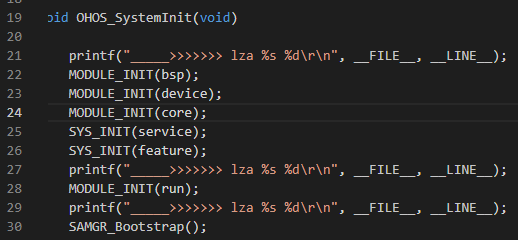
我们重新编译后烧录。打开串口查看打印信息,如下:
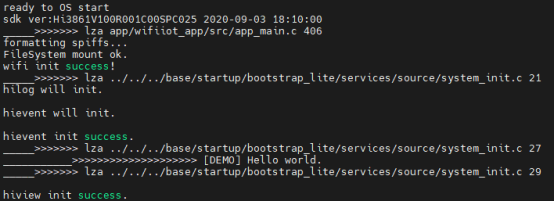
可以看到在27行之后,就打印 hello world的信息。符合预期。
回帖高级模式
声明:本文内容及配图由入驻作者撰写或者入驻合作网站授权转载。文章观点仅代表作者本人,不代表电子发烧友网立场。文章及其配图仅供工程师学习之用,如有内容图片侵权或者其他问题,请联系本站作侵删。 侵权投诉
